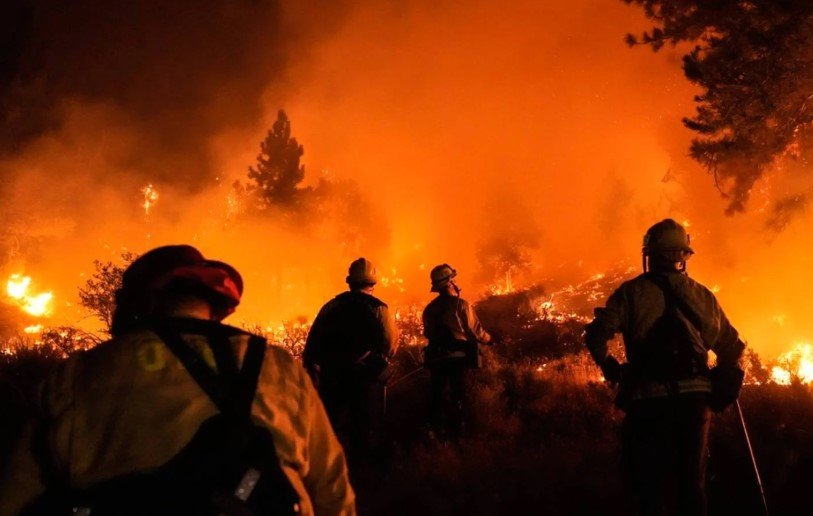Residents Face Dire Conditions Amid Massive Fire and Toxic Smoke
A large and fast-moving wildfire has forced the evacuation of over 50,000 people in Southern California as the flames threaten homes and communities north of Los Angeles. The Hughes Fire, which ignited late in the morning on January 22, 2025, quickly spread across rugged mountains near Castaic Lake, charring more than 15 square miles of land. As the fire burns through dry brush and trees, fears of potential mudslides and toxic air quality loom large.
The fire is just the latest in a series of disasters affecting Southern California. The region has already been struggling with the ongoing Eaton and Palisades fires, which have been burning for nearly three weeks. As high winds continue to fan the flames, the situation grows more dire.
Escaping the Flames: Thousands in Harm’s Way
By late Tuesday, local officials issued mandatory evacuation orders for thousands living in the path of the Hughes Fire. Residents in Santa Clarita and neighboring areas have been forced to flee their homes. Emergency responders, including local firefighting crews and state authorities, are working around the clock to contain the blaze, but the danger remains high.
The fire broke out close to Lake Castaic, a popular recreation spot in the area. For many, the fire’s rapid escalation has been a wake-up call. As flames consumed large swathes of dry brush, thick plumes of smoke billowed into the sky, signaling the immense scale of the disaster. Residents and visitors alike were caught off guard by the fire’s swiftness, with many evacuating as a precautionary measure.

A Perfect Storm: Wind, Drought, and Fire
The growing threat of the Hughes Fire highlights the dangerous combination of dry conditions, powerful winds, and an extended drought in Southern California. Local authorities warn that the fire’s rapid spread is exacerbated by the region’s parched environment and gusty winds that make fighting the flames an uphill battle. These conditions have been a hallmark of California’s wildfire season in recent years, with each season becoming more intense and destructive.
In addition to the fire itself, weather experts are keeping a close eye on the potential for heavy rains in the coming days. While rain could help dampen the fire, it also increases the risk of mudslides in areas already scorched by the flames. The risk of dangerous runoff also poses a threat to the region’s waterways, potentially contaminating the local environment.
The Strain on First Responders
Firefighting crews have been stretched thin as they battle multiple fires simultaneously across the region. The Hughes Fire is not the only active wildfire at the moment. With two other major blazes still burning, the firefighting resources have been spread across multiple fronts. The strain on these crews is immense, with long hours and challenging conditions testing their limits.
California’s firefighters are accustomed to high-intensity situations, but the magnitude of the current fires has raised serious concerns. As multiple fires burn in close proximity, the ability of firefighters to coordinate their efforts and secure critical resources becomes even more essential.
In the face of these challenges, authorities continue to call on residents to comply with evacuation orders. The risk of the fires growing uncontrollable is very real, and evacuation is considered the safest option for those in harm’s way.
Widespread Health Concerns Due to Toxic Air
In addition to the threat of flames and possible mudslides, the smoke from the fire poses a significant health risk. Air quality in affected areas has reached dangerous levels, with fine particulate matter making it hazardous to breathe. Local hospitals have reported an increase in patients with respiratory issues, especially among the elderly and children.
Even residents far from the fire’s immediate path are feeling the effects of the toxic smoke. Air quality reports have indicated unhealthy levels of pollution in many areas surrounding the fire zones. As the smoke drifts southward, more and more people are being affected by the toxic air, and health officials have advised everyone to stay indoors whenever possible.
The Long Road to Recovery
The wildfire season in California seems to be far from over, with new fires breaking out almost daily. As authorities continue to battle the flames, the long-term effects of this year’s wildfire season are already becoming clear. Residents in affected areas are bracing for weeks, if not months, of recovery work. From rebuilding homes to cleaning up the environmental damage, the road to recovery will be a long one.
For now, authorities are focused on getting the flames under control, ensuring that residents are safe, and monitoring the weather for any signs of relief. The coming days will be critical as officials continue to assess the damage and determine the next steps in the firefighting efforts.
